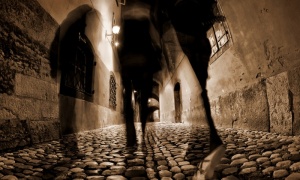The House of Plantagenet was an Anglo-French royal dynasty that came to prominence in the Middle Ages. Although the Plantagenets transformed England from what was essentially a realm ruled from abroad under the earlier Norman kings into a powerful and independent kingdom in its own right, they came from dark and uncertain origins. The roots of House Plantagenet can be traced back to the House of Anjou, usually referred to simply as the Angevins, a family of Frankish origin descended from a ninth-century noble named Ingelger, who were Counts of Anjou since 870. The chronicler Gerald of Wales, however, borrowed elements of the Melusine legend to give a demonic origin to the Angevins. Melusine was a figure of European legend and folklore, a feminine spirit of fresh waters in sacred springs and rivers. She is usually depicted as a woman who is a serpent or fish from the waist down, and is said to possess eternal life as the result of a curse. Over the centuries tales of Melusine have been told by chroniclers as diverse as Sir Walter Scott, Marcel Proust, Felix Mendelssohn and A S Byatt. Melusine’s demon blood partly explains the commonly held belief that Lady Elizabeth Woodville – wife of Edward IV and mother of the Princes in the Tower – was a witch. At any rate the Angevin monarchs never shied away from their supposedly supernatural origins. The famous English king Richard the Lionheart was reputedly fond of saying that his whole family “came from the devil and would return to the devil” as a result of their descent from the demon countess of Anjou.
The full story of Melusine tells of how in the time of the crusades, Elynas, the King of Alba (an old name for Scotland), went hunting one day and came across a beautiful lady in the forest. She was Pressyne, mother of Melusine. He persuaded her to marry him but she agreed, only on the promise — for there is often a hard and fatal condition attached to any pairing of fay and mortal — that he must not enter her chamber when she birthed or bathed her children. She gave birth to triplets. When he violated this taboo, Pressyne left the kingdom, together with her three daughters, and traveled to the lost Isle of Avalon. The three girls — Melusine, Melior, and Palatyne — grew up in Avalon. On their fifteenth birthday, Melusine, the eldest, asked why they had been taken to the island. Upon hearing of their father’s broken promise, Melusine sought revenge. She and her sisters captured Elynas and locked him, with his riches, in a mountain. Pressyne became enraged when she learned what the girls had done, and punished them for their disrespect to their father. Melusine was condemned to take the form of a serpent from the waist down every Saturday. Raymond of Poitou, an Angevin noble, came across Melusine in a forest of Coulombiers in Poitou in France, and proposed marriage. Just as her mother had done, she laid a condition, that he must never enter her chamber on a Saturday. He broke the promise and saw her in the form of a part-woman part-serpent. She forgave him but their happiness did not last long. When during a disagreement he called her a “serpent” in front of his court, she assumed the form of a dragon, provided him with two magic rings, and flew off, never to return.
However, the above is only one of many legends told of Melusine. When Count Siegfried of the Ardennes bought the feudal rights to Luxembourg in 963, his name became connected with the local version of Melusine. He also supposedly wed the demoness and this Melusine magically made the castle of Bock appear the morning after their wedding. As a consequence the royal house of Luxembourg also claims descent from the demon countess. Both Martin Luther and Goethe told tales warning of the evils of Melusine, calling her a succubus and worse. In Czech and Slovak, the word meluzína refers to wailing wind, usually in the chimney. This is a reference to the wailing Melusine looking for her lost children. The legend of Melusine has never been forgotten and has been immortalised in one of the icons of modern life. Ever wondered what that two-tailed siren on the front of your Starbucks coffee cup represents? It’s Melusine, of course, although what a demonic figure from ancient European mythology has to do with a skinny latte is something that I’ll leave to your imaginations!
















Hi there, I’m trying to compile information about cases of “demon children” in history, and I’d love it if you could provide any kind of assistance for my project. If you have any information at all, preferably with any historical sources, it would be appreciated a lot. If you can find any time at all to help me out with it, it would be amazing if you could send me an email about it. Thank you so much
I descend from Leonor de Castile who married Edward Plantagenet. I read every family has demons. Some are worse than others. Anytime there is irrational behavior in any age group it’s demon possesion. One must choose a religion, any religion and then you will be protected. Demons hate anything holy.